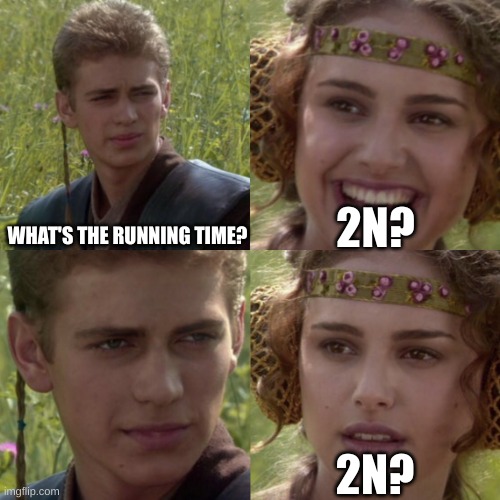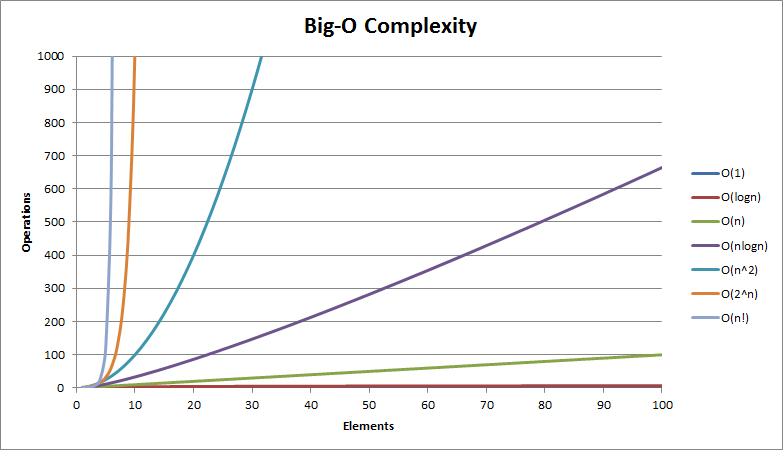The very first thing we tackle
Time and Space. Big O as they call it.
What is Big O
Big O is a way to categorize your algorithms time or memory requirements based on input. It is not meant to be an exact measurement. It will not tell you how many CPU cycles it takes, instead it is meant to generalize the growth of your algorithm.
Example
So when someone says Oh of N, they mean your algorithm will grow linearily based on input.
Why do we use it?
Often it will help us make decisions about what data structures and algorithms to use. Knowing how they will perform can greatly help create the best possible program out there.
So lets do a small example
First, Lets consider the following code.
function sum_char_codes(n: string): number {
let sum = 0;
for (let i = 0; i < n.length; ++i) {
sum += n.charCodeAt(i);
}
return sum;
}
For those that know big o, this is easy
But those who have never even classified a function, this may be a complete mystery. That is fine.
Big O, said differently
As your input grows, how fast does computation or memory grow?
Important concepts
- growth is with respect to the input
In the real world
obviously memory growing is not computationally free, but in the matter of thinking about algorithms, we don't necessarily think about that.
In languages like Go or JavaScript you pay even heavier penalties because the memory can be kept around, grows faster, and causes complete halts in your program for cleanup.
Lets go back to our example
Lets look at input. How does our program's execution time grow with respect to input?
function sum_char_codes(n: string): number {
let sum = 0;
for (let i = 0; i < n.length; ++i) {
sum += n.charCodeAt(i);
}
return sum;
}
Me> It may or may not be obvious, but we have an N relationship. O(N) time complexity
You> How can you tell?
Simplest trick for complexity
Look for loops
function sum_char_codes(n: string): number {
let sum = 0;
for (let i = 0; i < n.length; ++i) {
sum += n.charCodeAt(i);
}
return sum;
}
What's the running time
If the previous was O(N), what's this?
function sum_char_codes(n: string): number {
let sum = 0;
for (let i = 0; i < n.length; ++i) {
sum += n.charCodeAt(i);
}
for (let i = 0; i < n.length; ++i) {
sum += n.charCodeAt(i);
}
return sum;
}

Important concepts
- growth is with respect to the input
- Constants are dropped
O(2N) -> O(N) and this makes sense. That is because Big O is meant to
describe the upper bound of the algorithm (the growth of the algorithm). The
constant eventually becomes irrelevant.
Take the following:
N = 1, O(10N) = 10, O(N^2) = 1
N = 5, O(10N) = 50, O(N^2) = 25
N = 100, O(10N) = 1,000, O(N^2) = 10,000 // 10x bigger
N = 1000, O(10N) = 10,000, O(N^2) = 1,000,000 // 100x bigger
N = 10000, O(10N) = 100,000, O(N^2) = 100,000,000 // 1000x bigger
There is practical vs theoretical differences
Just because N is faster than N^2, doesn't mean practically its always faster for smaller input.
Remember, we drop constants. Therefore O(100N) is faster than O(N^2) but practically speaking, you would probably win for some small set of input.
Lets do another example
function sum_char_codes(n: string): number {
let sum = 0;
for (let i = 0; i < n.length; ++i) {
const charCode = n.charCodeAt(i);
// Capital E
if (charCode === 69) {
return sum;
}
sum += charCode;
}
return sum;
}
In BigO we often consider the worst case
Especially in interviews (i have never been asked for best, average, and worst
case, just worst case).
E = 69
Therefore any string with E in it will terminate early (unless E is the last item in the list).
ITS STILL O(N)
Important concepts
- growth is with respect to the input
- Constants are dropped
- Worst case is usually the way we measure,
The common complexities
Some examples
O(N^2)
function sum_char_codes(n: string): number {
let sum = 0;
for (let i = 0; i < n.length; ++i) {
for (let j = 0; j < n.length; ++j) {
sum += charCode;
}
}
return sum;
}
O(N^3)
function sum_char_codes(n: string): number {
let sum = 0;
for (let i = 0; i < n.length; ++i) {
for (let j = 0; j < n.length; ++j) {
for (let k = 0; k < n.length; ++k) {
sum += charCode;
}
}
}
return sum;
}
O(n log n)
- Quicksort (we will implement and explain)
O(log n)
- Binary search trees
There is one time that we will see today, that hasn't been mentioned
O(sqrt(n))
Why so obviated?
There are other resources out there to dive deep into big o notation. And I just don't think we need Yet Another Big O explanation. Instead I am going to focus on actively looking at running times and we will determine things together.
Important concepts
- growth is with respect to the input
- Constants are dropped
- Worst case is usually the way we measure
One more note
Is there anything else besides Big O? Well, there is technically a bunch of different ways to measure the complexity of algorithms, but in general the easiest one to use is the "Upper Bound"
Space the Final Frontier
We pretty much wont be going over space in this course. Just not something we will be discussing. I find this less consequetial in daily life considering I see things like this.
// or whatever it is in react
// O(N) time + O(N) space! COUNT ME IN
return <Component
...props />
Before we go
Questions?
